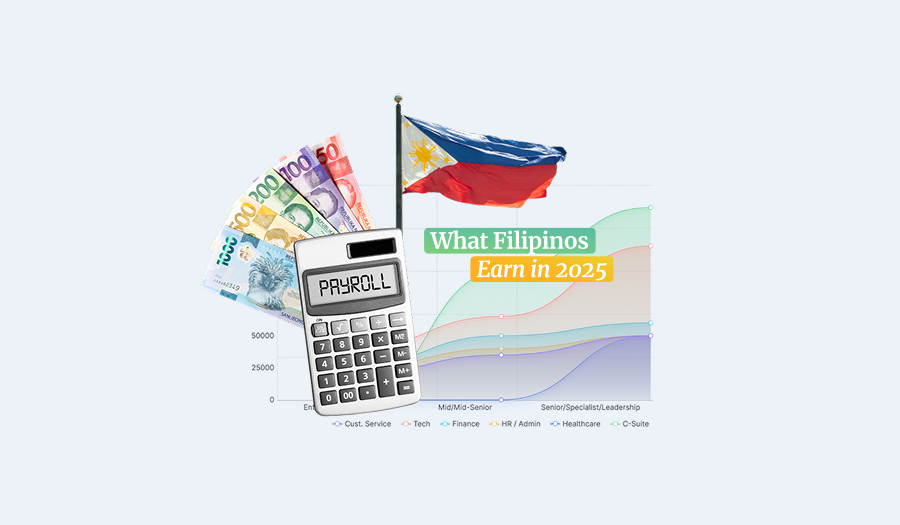Average Salary in the Philippines: 2025 Guide with Data & Insights

Key Takeaways:
- Philippine salary data is often outdated, and using old benchmarks can lead to underpaying or overspending when hiring remote talent.
- Most skilled professionals now earn ₱25,000 to ₱45,000 monthly, which is significantly higher than the official PSA average due to remote work and specialized roles.
- Salaries are projected to rise about 5.5 percent in 2025, with higher increases expected in competitive fields like tech, finance, and BPO.
- Location matters, with Metro Manila salaries typically 20 to 50 percent higher than provincial and rural rates.
- Employers should budget an extra 15 to 30 percent on top of base pay to cover mandatory benefits, contributions, compliance, and essential payroll costs.
- The Philippines remains cost-competitive in Southeast Asia, especially for English-facing roles, making it a top choice for global hiring compared to India, Vietnam, and Malaysia.
The Philippines continues to be a go-to choice for remote hiring, but many companies are working with stale salary data that can cause real headaches. Pay too little, and you'll struggle to attract talent. Pay too much, and you're burning cash unnecessarily.
We've put together a fresh look at Philippine compensation through 2025, diving into the details across different industries, locations, and experience levels. We'll show you how Philippine salaries stack up against other countries in Southeast Asia and walk you through what you actually need to budget for when hiring there - from basic pay to benefits and regulatory requirements.
Whether you're just starting to explore Philippine hiring or looking to update your compensation strategy, this guide will help you get it right.
This guide explains the average salary in the Philippines in 2025 and how wages are projected to move into 2026, helping employers plan with the most relevant data. Current compensation patterns suggest that most 2025 trends will carry forward into 2026 with similar upward pressure on wages, labor demand, and skill premiums.
What “Average Salary” Means, & Key Data Sources
Understanding Averages and Why They Matter
Before we look at the actual numbers, let's clear up a few important points:
First, there's a big difference between mean and median salaries. The mean (average) can be misleading since a few very high earners can pull it up significantly. The median, which shows the middle point where half earn more and half earn less, usually gives us a more realistic picture.
What Surveys Capture and What They Miss
When looking at salary data, keep in mind that official surveys mostly cover formal employment - think regular office jobs with benefits. They often miss out on freelancers, gig workers, and part-timers, who make up a huge part of our workforce.
You'll also notice some salary figures include allowances and bonuses, while others stick to basic pay only. It's important to know which is which when making comparisons.
Government Data and Trend Line
Finally, government surveys (like PSA's Occupational Wages Survey) focus on full-time workers who are paid by the hour or day in specific industries and job types. This helps them track trends, but doesn't capture the whole employment picture.
According to the PSA's 2022 wage survey, Filipino workers earned around ₱18,423 monthly on average across nearly 200 different jobs. But that's just the official number - real salaries these days tend to be higher, especially if you've got specialized skills or work remotely.
Looking at current job postings and data from places like JobStreet, most professionals and technical workers are making between ₱25,000 to ₱45,000 per month, though it really depends on your experience, where you're based, and what industry you're in.
From 2022 through 2025, average Filipino salaries have risen gradually, with most labor forecasts expecting similar mid-single-digit increases going into 2026.
2025 Trend & Projection: What to Expect
Salary Growth Forecast
Looking at the latest projections, salaries in the Philippines are expected to go up by around 5.5% in 2025 across most industries. If we take the average 2022 salary of ₱18,423 and factor in similar increases for 2023 and 2024, we're looking at roughly ₱20,300 to ₱21,000 for typical jobs (though this doesn't account for inflation or specialized positions).
Breaking down company budgets, Mercer Philippines says businesses are setting aside about 1% for promotions and 3% for market adjustments to keep salaries competitive with industry standards. Given the rising cost of living and the growing popularity of remote work, we'll likely see even bigger salary jumps for in-demand positions.
Inflation & Real Wage Pressure
Despite modest pay raises, workers are actually losing ground as inflation eats away at what their money can buy. To keep good employees from jumping ship, companies will likely need to sweeten the deal - either with bigger raises that actually outpace inflation or by offering attractive perks and benefits beyond just base pay.
Salary Benchmarks by Industry, Role & Experience
Suppose 2026 salary budgets hold steady at projected levels. In that case, most 2025 benchmarks for roles such as call center agents, accountants, software developers, designers, and customer service specialists will likely rise by roughly 5–6 percent.
Junior, mid-level, and senior roles are expected to follow similar percentage increases into 2026, with senior specialist roles seeing the strongest upward adjustments.
Tech, healthcare, finance, and high-growth outsourcing sectors will continue to experience tighter labor markets in 2026, which may push their wage increases slightly above the national average.

Philippines Salary Outlook for 2026
Raise Budgets for 2026
Most compensation researchers project that Philippine employers will set aside mid-single-digit increases for 2026, similar to 2025 levels. Global firms outsourcing to the Philippines are likely to follow comparable raise budgets.
Expected Minimum Wage Adjustments
Regional minimum wages in 2026 are expected to continue inching upward, driven by cost-of-living adjustments and inflation-indexed adjustments from the RTWPBs.
Skill Demand Trends
In 2026, training roles, IT specialists, data analysts, cybersecurity personnel, and niche BPO experts are expected to remain among the best-paid and fastest-growing job categories in the country.
Regional / Metro Manila vs Provincial & Adjustments
Spatial Premiums & Multipliers
Where you work in the Philippines makes a huge difference in how much you can earn.
If you're based in Metro Manila or NCR, you'll typically make way more money - sometimes 20-50% more - compared to working elsewhere in the country.
Moving down the pay scale, you've got the bigger provincial cities like Cebu, Davao, and Iloilo. People doing the same job in these cities usually earn about 20-35% less than their Manila counterparts.
The biggest pay gap shows up in rural areas and smaller provinces. Here, salaries can drop by 30-50% compared to Manila rates, though it really depends on what you do and how in-demand your skills are in that area.
Wages tend to be noticeably higher in Metro Manila compared to places like Central Luzon, Calabarzon, or the Visayas, according to data from the FOI Advisory Office.
A practical approach is to start with Manila rates as your baseline, then adjust downward for other regions - typically using multipliers, like 0.80 or 0.70, for example, of the Manila rate.
By 2026, the Manila premium over secondary cities is likely to persist, even if all regions see similar percentage increases.
Remote work adoption continues to reduce migration pressure into Metro Manila and may narrow absolute wage differences over time.
Provincial employers may feel stronger wage pressure in 2026 due to rising living costs outside the NCR.
Minimum Wages & Floors
Minimum wages vary by region in the Philippines, with different Regional Tripartite Wages and Productivity Boards (RTWPBs) setting local rates.
As of early 2024, workers in Metro Manila (NCR) earn around ₱610 per day in non-agricultural jobs, while those in more remote areas might only get about ₱385 daily. Employers who pay less than these regional minimums risk legal consequences - these rates are the absolute lowest they can legally pay their workers.
Most wage boards are expected to approve modest upward adjustments in 2026 aligned with petition activity and inflation trends.
Cost of Living, COLA & Inflation Considerations
Many employers will need to consider cost-of-living adjustments (COLAs) in 2026 to help keep real wages from falling further amid ongoing inflationary pressures.
Inflation in the Philippines is being pushed upward by several persistent factors, including rising food prices, transport costs driven by fuel volatility, and higher utility expenses across major cities. Housing and rental rates continue to climb, putting additional strain on household budgets.
These pressures reduce the real value of salary increases, which means even modest wage growth often fails to keep pace with day-to-day living expenses. For employers, understanding these inflation drivers is critical because they directly influence worker expectations, retention risks, and the need for competitive compensation adjustments heading into 2026.
Companies planning salary budgets for 2026 should model the impact of elevated inflation in housing, transportation, and food on employee retention.
Total Compensation & Employer Cost Considerations
Mandatory Benefits & Legal Requirements
When hiring in the Philippines, employers need to budget for several mandatory benefits and payments:
- The biggest one is 13th month pay - basically an extra month's salary that must be given to employees by the end of the year.
- You'll also need to handle the various social security contributions, including SSS, PhilHealth, and Pag-IBIG Fund payments for both you and your workers.
- Don't forget about standard compensation requirements like holiday pay, overtime rates, and extra pay for night shift work where relevant.
- Finally, there's all the behind-the-scenes administrative work - managing payroll, staying compliant with tax laws, dealing with insurance, and handling the general paperwork that comes with employment. It adds up, but these are essential costs of doing business in the Philippines.
Example: Estimating Total Cost to Employer
Here’s a hypothetical scenario for a mid-level software engineer:

As a rule of thumb, companies should set aside roughly 15-30% on top of an employee's base salary to cover benefits and overhead costs. This cushion helps account for things like insurance, taxes, and other essential employee expenses.
When budgeting for 2026, many employers assume base pay will need to rise by mid-single-digit percentages, plus the usual 15-30% load for benefits and overhead.
Remote/Offshore Hiring Effects
When hiring internationally, compensation gets more complex.
Exchange rates can be quite unstable, affecting how much employees actually take home. You'll also need to factor in fees from local payroll partners or legal entities that help you employ people abroad.
Benefits are another tricky area - what's standard in one country might not exist in another, so you may need to find creative ways to offer comparable packages. Plus, employees these days often expect their total comp to match what colleagues make globally, not just locally.
Cost-Per-Hire & Hiring Economics
Recruitment / Onboarding Costs
Hiring someone new comes with quite a few hidden costs that add up quickly. Such as:
- Costs involved with job boards and recruiting tools
- Time spent reviewing resumes, running assessments, and conducting interviews. Don't forget about checking references and running background checks - those aren't free either.
- Once you actually hire someone, you've got to invest in getting them up to speed with training and onboarding.
- Plus, while you're going through this whole process, that empty position is costing you money in lost productivity.
For professional positions, a good rule of thumb is that the total hiring costs typically run about 10-20% of what you'll pay them in their first year. It's not cheap, but it's the cost of finding the right person.
Example: For a new hire with base ₱60,000/month (₱720,000/year), recruiting + onboarding might cost ₱72,000–₱144,000 extra.
Attrition, Turnover & Retention Buffer
As an employer, you need to plan ahead and set aside budget for a few key things like:
- Retention bonuses/counteroffers
- Periodic salary refreshes (e.g. mid-year market adjustments)
- Talent pipeline/backfill buffer
Bottom line: investing in keeping good employees around costs way less than constantly hiring and training new ones.
Philippines vs Regional Peers: India, Vietnam, Malaysia
Comparative Benchmarking
When looking to outsource work, you can't just focus on salaries. Sure, salary costs matter - but you've got to think about whether your team can communicate clearly in English, if they'll mesh well with your company culture, and if the total package actually saves you money in the long run.
Below is a comparison table of average monthly salaries for key roles in the Philippines, India, Vietnam, and Malaysia, adjusted to USD for consistency.
Salary Comparison by Role & Country

FAQs
- What is the average salary in Manila in 2025?Skilled professionals typically earn between ₱45,000 to ₱60,000 monthly, though this varies by industry and role. These figures are higher than provincial rates due to the Metro Manila premium.
- How much do call center agents earn in the Philippines?In the BPO industry, fresh call center agents usually start at ₱15,000 to ₱25,000 per month. With experience, agents can move up to ₱25,000-₱40,000, while team leaders and supervisors can earn upwards of ₱40,000 monthly.
- What’s a good salary for a software developer in PH in 2025? Mid-level developers make around ₱50,000 to ₱80,000 monthly. Senior developers and those with specialized skills can earn ₱80,000 to ₱150,000+, especially if they work remotely or use in-demand technologies.
- What’s a good salary for a software developer in the Philippines in 2026? Mid-level developers make around ₱50,000 to ₱80,000 monthly. Senior developers and talents with niche skills can earn ₱80,000 to ₱150,000+, especially if they work remotely or use in-demand technologies.
- How much extra does an employer spend beyond base salary?Employers should budget an additional 15-30% on top of base salaries to cover mandatory benefits like 13th month pay, healthcare, government contributions, and other perks, particularly for remote workers.
- How do Philippine salaries compare to India/Vietnam/Malaysia?Philippine salaries tend to be higher than India and Vietnam for roles requiring strong English skills and client interaction. However, when considering purchasing power, the differences aren't as significant. Malaysian salaries generally remain higher across most industries.
Tying It Back: Why AbroadWorks Matters
Getting salary right in the Philippines can be tricky, but that's where partners like AbroadWorks and Olamee really shine. They know the local market inside and out, giving you real insights into what competitive pay looks like right now.
The best part? They handle all the complicated stuff. From social security and healthcare to tax withholding and labor laws - they've got it covered. No need to stress about setting up a legal entity or figuring out local regulations.
These partners help you avoid common pitfalls like misclassifying workers or creating pay gaps. They keep your costs in check while making sure everything's done by the book.
Need to hire quickly? They can speed up your recruitment process and help keep your Filipino team stable and engaged. Plus, they know exactly what benefits and perks matter most to local talent.
Working with them lets you offer the best of both worlds: competitive global packages that still make sense for the Philippine market. You can attract great talent without breaking the bank or causing local market disruption.
Use this 2025–2026 Philippines salary guide as a baseline for workforce planning, then partner with a local expert like AbroadWorks to refine your compensation ranges as updated 2026 data becomes available.





